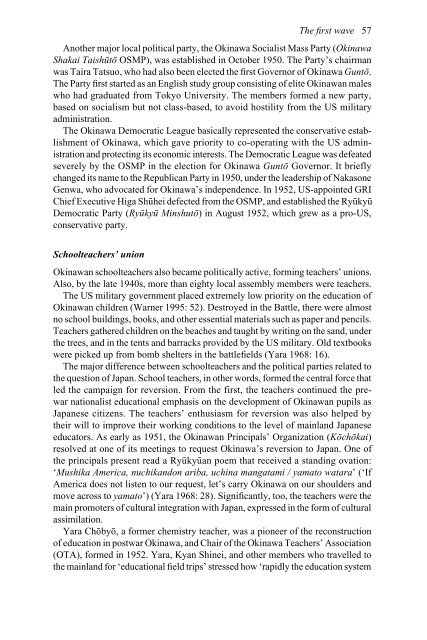Myth, Protest and Struggle in Okinawa
Myth, Protest and Struggle in Okinawa
Myth, Protest and Struggle in Okinawa
You also want an ePaper? Increase the reach of your titles
YUMPU automatically turns print PDFs into web optimized ePapers that Google loves.
The first wave 57<br />
Another major local political party, the Ok<strong>in</strong>awa Socialist Mass Party (Ok<strong>in</strong>awa<br />
Shakai Taishūtō OSMP), was established <strong>in</strong> October 1950. The Party’s chairman<br />
was Taira Tatsuo, who had also been elected the first Governor of Ok<strong>in</strong>awa Guntō.<br />
The Party first started as an English study group consist<strong>in</strong>g of elite Ok<strong>in</strong>awan males<br />
who had graduated from Tokyo University. The members formed a new party,<br />
based on socialism but not class-based, to avoid hostility from the US military<br />
adm<strong>in</strong>istration.<br />
The Ok<strong>in</strong>awa Democratic League basically represented the conservative establishment<br />
of Ok<strong>in</strong>awa, which gave priority to co-operat<strong>in</strong>g with the US adm<strong>in</strong>istration<br />
<strong>and</strong> protect<strong>in</strong>g its economic <strong>in</strong>terests. The Democratic League was defeated<br />
severely by the OSMP <strong>in</strong> the election for Ok<strong>in</strong>awa Guntō Governor. It briefly<br />
changed its name to the Republican Party <strong>in</strong> 1950, under the leadership of Nakasone<br />
Genwa, who advocated for Ok<strong>in</strong>awa’s <strong>in</strong>dependence. In 1952, US-appo<strong>in</strong>ted GRI<br />
Chief Executive Higa Shūhei defected from the OSMP, <strong>and</strong> established the Ryūkyū<br />
Democratic Party (Ryūkyū M<strong>in</strong>shutō) <strong>in</strong> August 1952, which grew as a pro-US,<br />
conservative party.<br />
Schoolteachers’ union<br />
Ok<strong>in</strong>awan schoolteachers also became politically active, form<strong>in</strong>g teachers’ unions.<br />
Also, by the late 1940s, more than eighty local assembly members were teachers.<br />
The US military government placed extremely low priority on the education of<br />
Ok<strong>in</strong>awan children (Warner 1995: 52). Destroyed <strong>in</strong> the Battle, there were almost<br />
no school build<strong>in</strong>gs, books, <strong>and</strong> other essential materials such as paper <strong>and</strong> pencils.<br />
Teachers gathered children on the beaches <strong>and</strong> taught by writ<strong>in</strong>g on the s<strong>and</strong>, under<br />
the trees, <strong>and</strong> <strong>in</strong> the tents <strong>and</strong> barracks provided by the US military. Old textbooks<br />
were picked up from bomb shelters <strong>in</strong> the battlefields (Yara 1968: 16).<br />
The major difference between schoolteachers <strong>and</strong> the political parties related to<br />
the question of Japan. School teachers, <strong>in</strong> other words, formed the central force that<br />
led the campaign for reversion. From the first, the teachers cont<strong>in</strong>ued the prewar<br />
nationalist educational emphasis on the development of Ok<strong>in</strong>awan pupils as<br />
Japanese citizens. The teachers’ enthusiasm for reversion was also helped by<br />
their will to improve their work<strong>in</strong>g conditions to the level of ma<strong>in</strong>l<strong>and</strong> Japanese<br />
educators. As early as 1951, the Ok<strong>in</strong>awan Pr<strong>in</strong>cipals’ Organization (Kōchōkai)<br />
resolved at one of its meet<strong>in</strong>gs to request Ok<strong>in</strong>awa’s reversion to Japan. One of<br />
the pr<strong>in</strong>cipals present read a Ryūkyūan poem that received a st<strong>and</strong><strong>in</strong>g ovation:<br />
‘Mushika America, nuchik<strong>and</strong>on ariba, uch<strong>in</strong>a mangatami / yamato watara’ (‘If<br />
America does not listen to our request, let’s carry Ok<strong>in</strong>awa on our shoulders <strong>and</strong><br />
move across to yamato’) (Yara 1968: 28). Significantly, too, the teachers were the<br />
ma<strong>in</strong> promoters of cultural <strong>in</strong>tegration with Japan, expressed <strong>in</strong> the form of cultural<br />
assimilation.<br />
Yara Chōbyō, a former chemistry teacher, was a pioneer of the reconstruction<br />
of education <strong>in</strong> postwar Ok<strong>in</strong>awa, <strong>and</strong> Chair of the Ok<strong>in</strong>awa Teachers’ Association<br />
(OTA), formed <strong>in</strong> 1952. Yara, Kyan Sh<strong>in</strong>ei, <strong>and</strong> other members who travelled to<br />
the ma<strong>in</strong>l<strong>and</strong> for ‘educational field trips’ stressed how ‘rapidly the education system
















